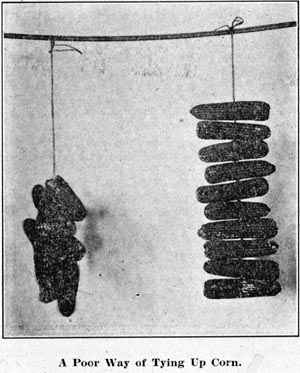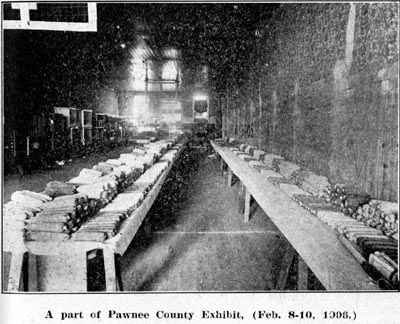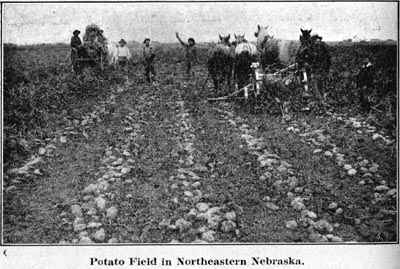
NEGenWeb
Project
Resource Center
Schools
|
278 |
|
Probably the best known place to store seed corn in over the drive way of a double corn crib. Here it is out of the way and has a free circulation of air. Another good place is a well ventilated attic. In selecting a place to store seed corn, one should always keep these two things in mind: First, seed corn, during the "drying out" process, requires a free circulation of air at a temperature above freezing. Second: It should be hung in such a way and place that mice, rats or other pests cannot get at it.
"But," we say, "all the collecting and storing of seed corn, takes too much time." Did you ever stop to think that it takes but twelve medium sized seed ears to plant an acre of corn? That next year's crop largely depends on the selection and care of an armful, a good horse feed, of corn for each acre of corn you plant? It seems reasonable that if the law, "Like will produce like" is true there is no job on the farm that should receive so much care and attention as the selection of our seed corn each fall.

|
|
279 |

SELECTING A SAMPLE OF CORN FOR SHOW.
Notice--
Rule 1. All ten-ear exhibits having one or more ears with an off-colored cob, or having a total of more than twenty off-colored kernels on the ten ears, which in the estimation of the judge is due to a mixture of white and yellow types of corn, shall be disqualified--unless entered in classes for other than yellow or white varieties.
Rule 2. Any ear entered in the single-ear class, which in the estimation of the judge shows a mixture of white and yellow varieties either in the kernels or in the cob, shall be disqualified--unless entered in a class for other than yellow or white varieties.
A ten-ear show sample should be uniform throughout. The ears should be of the same roughness, shape, length, circumference, etc. The tips and butts should be equally well filled on all ears, and covered with kernels of the same size and shape. If ears are of the same circumference and have the same number of rows, the kernels will be of the same width. The germs should be of the same general size and shape. The ten ears should be of the same shade of yellow or white, and free from mixtures in both the cob and kernels.
The following score card will assist the amateur in selecting corn for the show room:
|
280 |
|
|
ADAPTABILITY |
|
||
Size of ears |
|
|
|
Ripeness |
|
|
|
Filling of kernel |
|
|
|
|
UNIFORMITY |
|
||
Of ears |
|||
Size |
|
|
|
Shape |
|
|
|
Color |
|
|
|
Indentation |
|
|
|
Of Kernels |
|||
Size |
|
|
|
Shape |
|
|
|
|
SOUNDNESS AND VIABILITY |
|
||
Condition of Germ |
|
|
|
Condition of Hull |
|
|
|
Freedom from Injury |
|
|
|
Solidity of Ears and of |
|||
Kernels on Cob |
|
|
|
|
SHAPE OF EARS |
|
|
|
|
COLOR OF COBS |
|
|
|
|
COLORS OF KERNELS |
|
|
|
|
SHAPE OF KERNELS |
|
|
|
|
BUTTS AND TIPS |
|
|
EXPLANATORY NOTES.
Adaptability: (20) Of great importance in selecting seed corn. Indicated in part by the following:
(a) Size of Ear. (10) The following sizes are given as representative of each section.
Eastern Section: Length, 91/2 inches, circumference, 7 inches.
Western Section: Length, 8 inches; circumference, 6 inches.
(b) Ripeness. (5) An essential quality in corn. Indicated by solidity of kernels, rigidity of cob and firmness of kernels on cob. If immature, the kernels may contain some sap. Such kernels often loose their tip caps in shelling.
(c) Filling of Kernels: (5) Kernels of medium roughness are considered best. The kernels with a chaffy crown "pinched dent" is indicative of late maturity.
Uniformity: (30) Necessary in all exhibits. Hence the ears and kernels of the exhibit should possess uniform characteristics. For purposes of study, two kernels may be removed from one row in each ear between three and four inches from the butt.
Soundness and Viability: (25) Of great importance. Seed that will not grow is worse than worthless.
|
|
281 |
(a) Condition of Germ: (10) The germ should be bright and oily. A pale, shrunken, dull looking germ indicates poor vitality. A dark colored one indicates injury from frost or moisture or from both.
(b) Condition of Hull: (5) Germination tests show that kernels with a blistered or wrinkled hull will either not grow or are of low vitality--the lack of vitality varying with the degree of blister.
(c) Freedom from Injury: (5) There should be no missing, mouldy, cracked or otherwise injured kernels. (The two kernels removed for study, excepted).
(d) Solidity of Ears and of Kernels on Ears: (5) Ears should be firm. In many cases looseness of kernels and weakness of cob indicates poor vitality.
Shape of Ears: (5) Varies with variety. In general the ears should be cylindrical or nearly so. A good rule is "circumference three-fourths the length." (The circumference measured at one-third the length of the ear from the butt).
Color of Cobs: (5) Grain free from evidence of mixing shows careful breeding. Cobs of uncertain tints suggest impure breeding.
Color of Kernels. (5) The same rule holds as for color of cob.
Shape of Kernels: (5) Kernels should narrow gradually from crown to tip, with straight edges that touch full length. The two sides of the kernels facing ends of the ear should be parallel. The shoe-peg type of kernel is objectionable.
Butts and Tips: (5) The butt should be smoothly rounded over with straight rows of uniform kernels. The shank should not be too large, but should have sufficient size to support the ear.
Tips should be covered well towards the end with straight rows of uniform kernels. Irregular, shallow or small kernels are more objectionable than tips somewhat exposed. Very tapering tips are objectionable.
"TO THE COUNTY SUPERINTENDENT."
Making the Entries.
Where possible the white uniform tags should be used. These can be attached to the ears of corn with a rubber band. On the aprons and the dress goods the tag should be fastened with a pin. After the exhibits have been judged the contestant's name, address, etc., should he filled in on the entry tag.
Shipping to the State Show.
After the show is over, the exhibits should be placed in strong boxes lined with screen. They should then be nailed up tightly and set away. In case the corn is too green to pack, hang each contestant's sample on a string suspended from a wire or some other place where it will be impossible for mice to reach it. Every precaution should be taken to protect the children's exhibits from mice, rats, water, etc.
|
282 |
|
(By Val Keyser.)
The first thing is to study the score card and become thoroughly acquainted with the requirements of the card. This score card was drawn up for the boys' contest work, it being necessary to have a standard by which the exhibitors and the judge can be guided. As soon as you are familiar with the essential points which compose a good exhibit, place the potatoes which have been chosen as worthy of consideration on a table before you, and carefully select the twelve best tubers which conform to the regulations of the score card. If two exhibits are equally good in all respects, except size, the larger potatoes will be given first place unless the judge should deem them too large. It has been found that medium-sized tubers of proper shape usually cook better and are more profitable for seed and for the market. This applies to early varieties rather than late.
Variety Name ..........................................................................
|
|
|
|
|
|
Uniformity of Exhibit |
|
|
|
|
Trueness of Type |
|
|
|
|
Shape of Tuber |
|
|
|
|
Size of Tuber |
|
|
|
|
Eyes |
|
|
|
|
Skin |
|
|
|
|
Texture of Tuber |
|
|
|
|
Soundness |
|
|
|
|
Freedom from Blemishes |
|
|
|
Totals |
|
|
|
Contestant's Name .................................................................
Date .............................................
Uniformity of Exhibit--Select twelve potatoes that are uniform in size, color, and which have uniformly well defined eyes of the same depth.
Trueness to Type--Each potato should be typical of the variety to which it belongs, i. e., the characteristics should be clearly defined, enabling one to easily identify it.
Shape of Tuber--The shape of the potato will depend largely upon variety, but the fiat-round or oval shape is favored, because these shapes usually give best quality tubers.
Size of Tuber--As a rule, select medium-sized potatoes, but if two exhibits are otherwise equal, choose the larger, unless potatoes
|
|
283 |
are so large as to be considered overgrown.
Eyes--The eyes of the potato should be medium deep, well defined and not too numerous. Deep eyes cause waste in peeling and have a tendency to affect shape of tuber. Eyes too shallow are low in vitality.
Skin--The skin may be whitish, brown, reddish, yellowish brown, blue or black, depending on variety. It may be thick or thin, tough or brittle. A thick, fairly tough skin is preferred, lenticels not too prominent, or potatoes sunburned.
Texture of Tuber--This is determined by cutting tuber. A fairly fine grained, brittle texture is preferred. A tough texture does not cook up mealy and is usually poor in flavor.
Soundness--Select potatoes that are sound, and firm, not wrinkled and flabby. Hollow potatoes are objectionable, likewise any internal discoloration indicating a diseased condition. The judge should cut two potatoes in each exhibit.
Freedom from Blemishes--The judge will deduct from score for scab spots or skin ruptures from any other disease, cuts, bruises, scratches or any other defects.
A large potato Is a potato larger than the average twelve year old boy's fist.
A medium sized potato is a potato larger than an average size hen's egg, but smaller than a twelve year old boy's fist.
A small potato is a potato smaller than an average size hen's egg, but larger than an English walnut.
A cull is a potato smaller than an English walnut and also scabby, badly sun burned, decayed or badly bruised. In fact, culls include all potatoes that are not fit for the market.
Directions--Plow out each row of potatoes carefully and in such a way that the potatoes from one row will not become mixed with the potatoes from connecting rows. Gather all the potatoes including the small and scabby ones. Collect the potatoes from the first row, which will be the one containing the products from the one-eighth potatoes planted in each hill. Weigh these potatoes and mark weights in the proper square under "B." Divide the potatoes into large, medium, small and cull lots. Weigh each lot and write the weights in the proper square under "C," "D," "E," and "F." -
To Find the Per Cent of Large Potatoes--Divide the number of pounds of large potatoes by the total weight of potatoes in the row, and insert the figure in the proper square under "G."
To Find the Per Cent of Medium Potatoes--Divide total weight of medium potatoes by the total weight of potatoes in the row and Insert the figure in the proper square under column "H."
To Find the Per Cent of Small Potatoes--Divide the total weight of small potatoes by the total weight of potatoes in the row and insert In the proper square under "I."
|
284 |
|
To Find the Per Cent of Culls--Divide the total weight of culls by the total weight of potatoes in the row and insert in the proper square under "J."

To Find the Number of Bushels Per Acre--Divide the total number of pounds of potatoes raised on each row by 100 (the number of hills in each row). Multiply this number by 8306 (the number of hills on an acre when planted 18 inches apart in rows 3 feet 6 inches apart). Divide this number by 60 (the number of pounds in a bushel of potatoes). The result will be the number of bushels per acre.
SOME CORN DEFINITIONS AND DIRECTIONS FOR FINDING PER CENT OF STAND.
A Sucker is a stalk without roots of its own. It Is usually attached to another stalk below or very near the surface of the ground. Care should be taken not to confuse suckers and barren stalks.
A Barren Stalk is a stalk without an ear on it.
A Smutted Stalk is a stalk containing smut, a black, powdery substance, on any part of the stalk or ear.
To Count the Stand--Begin at the first hill in the first row and count all the stalks in each hill in the row. Mark down the number of stalks in each hill. These correspond with the number of hills in the row. If a hill contains no stalks write 0; if it contains one stalk write 1, etc. After the first row is completed count the second row and so on until the hills in each row are counted.
 |
 |
 |
 |
|
© 2003 for the NEGenWeb Project by Ted & Carole Miller |
|||